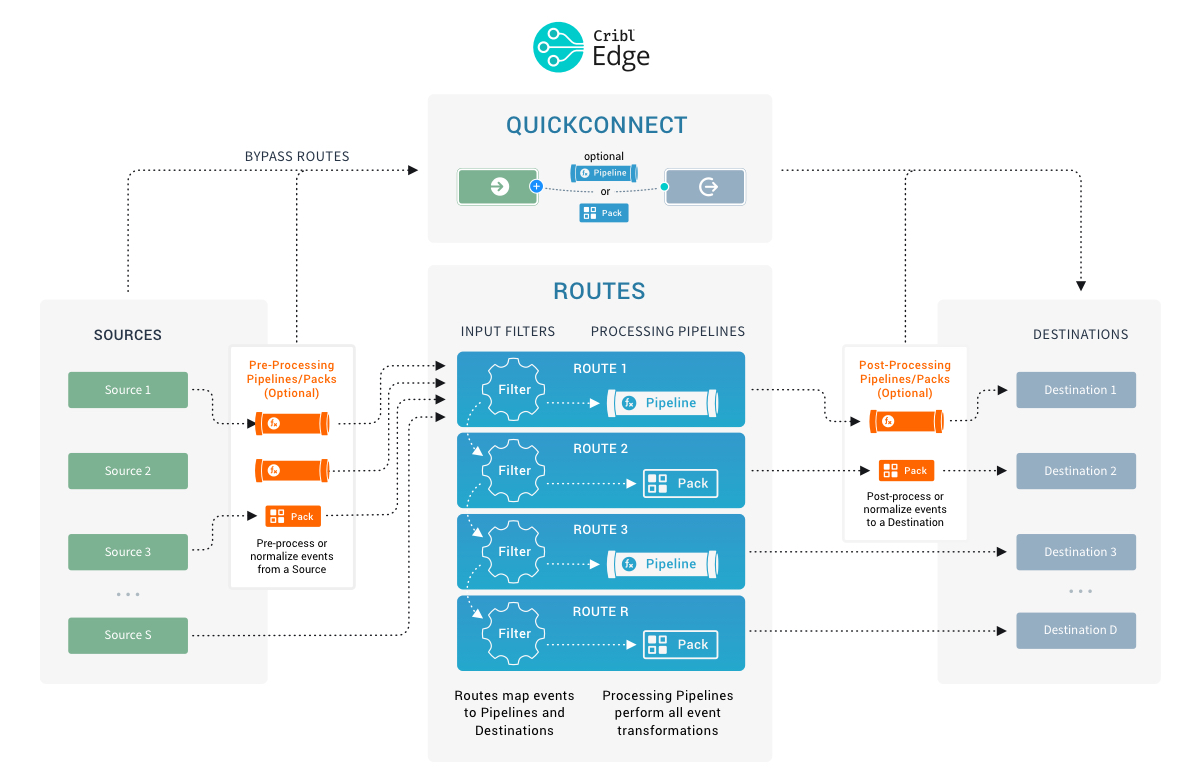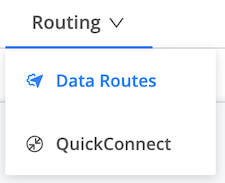These docs are for Cribl Edge 4.3 and are no longer actively maintained.
See the latest version (4.15).
Basic Concepts
Notable features and concepts to get a fundamental understanding of Cribl Edge
As we describe features and concepts, it helps to have a mental model of Cribl Edge as a system that collects and process observability data - logs, metrics, application data, etc. - in near real time, from your Linux and Windows machines, apps, microservices etc., and delivers them to Cribl Stream or any supported destination.

Let’s zoom in on the center of the above diagram, into an Edge Node, to take a closer look at the processing and transformation options. The basic interface concepts to work with are Sources, which collect data; and Routes, which manage data flowing through Pipelines, which consist of Functions.

Sources
Sources are configurations that enable Edge to collect data from the local machine (logs, metrics, etc.) or to receive data from remote senders (TCP, Syslog etc. ).
QuickConnect
QuickConnect is a graphical interface for setting up data flow through your Edge deployment. You can quickly drag and drop connections between Sources and Destinations, optionally including - or excluding - Pipelines or Packs.
The only major constraint is that QuickConnect completely bypasses Routes. So QuickConnect configurations have no Routing table, and no conditional cloning, cascading, or routing of data - every QuickConnect connection is parallel and independent.
You use the top nav’s Routing menu to toggle between the Data Routes and QuickConnect interfaces.

Routes
Routes evaluate incoming events against filter expressions to find the appropriate Pipeline to send them to. Routes are evaluated in order. Each Route can be associated with only one Pipeline and one output (configured as a Edge Destination).
By default, each Route is created with its Final flag set to Yes. With this setting, a Route-Pipeline-Destination set will consume events that match its filter, and that’s that.
However, if you disable the Route’s Final flag, one or more event clones will be sent down the associated Pipeline, while the original event continues down Edge’s Routing table to be evaluated against other configured Routes. This is very useful in cases where the same set of events needs to be processed in multiple ways, and delivered to different destinations. For more details, see Routes.
Pipelines
A series of Functions is called a Pipeline, and the order in which you specify the Functions determines their execution order. Routes deliver Events to the beginning of a Pipeline, and as they’re processed by a Function, the events are passed to the next Function down the line.

Pipelines attached to Routes are called processing Pipelines. You can optionally attach pre-processing Pipelines to individual Edge Sources, and attach post-processing Pipelines to Edge Destinations. All Pipelines are configured through the same UI - these three designations are determined only by a Pipeline’s placement in Edge’s data flow.

Events only move forward - toward the end of a Pipeline, and eventually out of the system. For more details, see Pipelines.
Functions
At its core, a Function is a piece of code that executes on an event, and that encapsulates the smallest amount of processing that can happen to that event. For instance, a very simple Function can be one that replaces the term foo with bar on each event. Another one can hash or encrypt bar. Yet another function can add a field - say, dc=jfk-42 - to any event with source=*us-nyc-application.log.

Functions process each event that passes through them. To help improve performance, Functions can optionally be configured with filters, to limit their processing scope to matching events only. For more details, see Functions.





